ShodhKosh: Journal of Visual and Performing ArtsISSN (Online): 2582-7472
|
|
Geometry in Warli: Merging Folk Art with Mathematics Teaching
Dr. Anjali
Sharma 1![]()
![]() , Sukanya Singh 2
, Sukanya Singh 2![]()
![]() , Vikash Kumar 3
, Vikash Kumar 3 ![]()
![]()
1 Professor,
School of Education, Central University of Rajasthan, India
2 Research
Scholar, School of Education, Central University of Rajasthan, India
3 Master’s Student, School of Education, Central
University of Rajasthan, India
|
|
ABSTRACT |
||
|
The study was
themed on art integration (folk art “Warli” and geometry images) in
mathematics teaching and its effect on learners' achievement. The objectives
were (i) to develop art-integrated mathematical
instructional modules to teach mathematical concepts and (ii)To measure the
effect of an art-integrated mathematical instructional intervention on
learner achievement. The quasi-experimental post-test research design with a
single group post-test design was used. 45 participants of 7th-grade students
from Govt Upper Primary School have been selected. The intervention was
designed on the Triangle and its Properties through Warli folk art and
geometry images. After obtaining post-test scores, data analysis was done.
Therefore, learners' overall achievement was based on learning outcomes. The
results revealed that the range of achievement was between 60-95%, and
achievement of remembering, understanding, and applying learning objectives
was 89%, 83%, and 84%, and analyzing learning outcomes achieved 64% while
evaluating and creating learning outcomes were committed to 63 % and 69 %.
The results showed that the art-integrated instructional intervention was
found to be positive in higher-order cognitive abilities. |
|||
|
Corresponding Author Sukanya
Singh, sukanyasingh6@gmail.com DOI 10.29121/shodhkosh.v5.i1.2024.1475 Funding: This research
received no specific grant from any funding agency in the public, commercial,
or not-for-profit sectors. Copyright: © 2024 The
Author(s). This work is licensed under a Creative Commons
Attribution 4.0 International License. With the
license CC-BY, authors retain the copyright, allowing anyone to download,
reuse, re-print, modify, distribute, and/or copy their contribution. The work
must be properly attributed to its author.
|
|||
|
Keywords: Art-Integration, Folk Art and Geometry Images, Mathematics
Teaching, Learners' Achievement |
|||
1. INTRODUCTION
Instruction and direct action are urgently needed in mathematics education to improve students' accuracy and comprehension. An observed fact is that mathematics teachers value creating an engaging and stimulating environment that considers learners' experiences and future attitudes to engage them in mathematics. The focus should be on creating formative experiences and assisting students in acquiring creative inclinations, including flexibility, perseverance, curiosity, intuition, and creativity, which are crucial for learning mathematics (Hutchinson, 2005). Art can uniquely identify, develop, and promote critical thinking, communication, collaboration, and creativity. The arts can be integrated into all forms of learning across all disciplines and levels. In the words of Brunkalla (2009) outstanding abilities such as curiosity, communication, and expression may be developed through artistic integration which can create a positive link between academic success and arts inclusion. Surprisingly, an art-integrated approach to teaching mathematics provides a stimulating environment to the mathematics class as it talks about multiple ways of understanding. Teaching mathematics with art integration is not a new phenomenon in education. It existed in mathematics in ancient times as “Bhaskar Acharya” wrote “Lilavati text” in poetic form, including mathematical operations to be solved by some techniques and formulas considered Vedic mathematics (Bresler, 1995). Thus, researchers affirm the link between mathematics and the arts traces back to the prehistoric epoch.
Generally, mathematics and Art seem like two poles of a magnet as “mathematics is considered the mother of all sciences, and art has the same for humanities”. Confer to this, “Mathematics always deals with numbers, logic, abstractness, structures, theorems, facts, and evidence, while art deals with feelings, emotions, derives, motives, and passion (DeMoss and Morris, 2002). Mathematical and artistic connections have been proven by many academicians to extol the uniqueness and usefulness of blending these two fields. Particularly, some contend that incorporating arts in mathematics instruction assists in establishing a close connection between mathematical concepts that are both concrete and abstract (Winner et al., 2007). In addition, some scholars assert that when learners cognitively link learning content to real-world contexts, for instance, they encounter the arts and learn more effectively. Furthermore, they argue that forging linkages between mathematics and other disciplines does not hinder students' ability to use mathematics effectively. The integration of Art into mathematics is recommended to achieve a holistic approach to learning.
Educators of all disciplines acknowledge the significance of arts integration in their fields, especially math teachers. Gustline (2012) cited that McCollum illustrates how geometry activities can engage students with limited spatial cognition. Using artistic materials, they learn and scoop up math. McColm underlines that if students have prior knowledge of art experiences, they won't struggle over the learning opportunity to study. Thus, art is acknowledged as the foundation of an effective curriculum.
Gustin (2012) reports that cross-curricular integration and experiential learning (hands-on activities through Art) engage the learner's imagination as an effective tool to hold students' attention and prevent them from becoming overwhelmed by the blackboard. Consequently, she started incorporating Art into the school curriculum to integrate Art into teaching for learners to be active, focused, and motivated and came to the conclusion that multifaceted and creative skills are demanded in fields like physics, language, and mathematics. Thus, art integration is a way of educating students and providing the scope of how children can learn best. Therefore, Art can be a way of teaching content that is more inspiring than the usual way.
Concerning “Art integration” in education, the Indian NEP 2020 recommendation states that "Art integration is a cross-curricular pedagogical instructional strategy that employs multiple elements and forms. It is a root for education concepts. A portion of the more practical education, integrated art instruction can focus on schoolroom activities and not just by creating enjoyable classrooms but also by instilling Indian values over the integration of Indian Art and nation in the instruction and learning progression at all levels. This united approach Art may support the link between education and principles" (National Education Policy 2020, P. 4.7).
In the present scenario, it is demanded to do art integration in various disciplines as a cross-curricular pedagogical approach to teaching concepts in different fields. The present study has themed on the art integration in mathematics as a cross-curricular approach.
2. Literature Review
2.1. Art integration
Arts integration is a "cross-curricular pedagogical approach" that aims to expand students' understanding of both the arts and non-arts curriculum through the integration of the arts (Beena & Atladara, 2021). The culture of the entire classroom can be influenced by arts inclusion with focused energy when they actively participate (Conway, 2019; Goldberg, 2016). Art is an individual’s creative expression that has the power to convey thoughts of the human mind. Art genres classified as visual arts include architecture, video, painting, crafts, design, photography, sculpture, and printing (Torres, 2020). Aspects of the visual arts and other forms of arts are present in many artistic fields (such as textile Art, Conceptual Art, and performing arts). However, in addition to being primarily for aesthetic objectives, applied visual arts also include ornamental arts, decorative Art, computer art, calligraphy, fashion design, interior design, jewellery design, woodcraft, and so on (Conway, 2019).
In a broad sense, the premise and integration of visual arts in the classroom are not as challenging as one might think. Visual arts are a better fit for naturalistic, comprehensive, and actual learning. Conway (2019) distilled Art into three categories as a part of school education; "Art as Curriculum," "Art- Enhanced Curriculum," and "Arts-Integrated Curriculum." Thus, integrated art curricula are core to engaging in the creative process. Numerous connections exist between mathematics and the arts, and both fields require the ability to think rationally despite the extensive efforts of teachers to foster mathematical thinking and explain the relationship between Art and mathematics to meet standards in both math and geometry. The integration of the visual arts has confirmed that sustained engagement in art activities may aid students' mathematical reasoning drawing from visual imagination, and reflection on how to develop original ideas. In addition, teachers who actively engage in all these activities are armed with information that can assist students in rediscovering what initially interested them in teaching.
2.2. Integration of Folk Art Basics in Mathematics Education
For thousands of years, folk art has been passed from generation to generation. Ancient people produced several works of art and art forms via diligence and insight (Jiang, 2020). Importantly, folk art is a priceless component of any nation reflected in a rich heritage of Art and culture, which must be preserved and continue to be practiced in all of its forms to beautify the environment. There is a close association between folk art and folklore rituals, such as festivals and ceremonies, holiday celebrations, sacrifices, and so forth (Jiang, 2020). These activities often incorporate art forms like paper-cutting, candles, mud toys, pottery sculptures, and artwork. Additionally, ethnic minorities' festival attire and decorations are considered forms of folk art. Using these artistic elements in math instruction can enable the students to comprehend certain cultural and religious beliefs, broadening their horizons while also helping to bring math education closer to daily life (Akhmetova, Mayorov & Makhmutova, 2016).
The importance of art integration in education helps the students to learn various art forms and develop a deeper understanding of Art. Teachers can use folk art aspects in the classroom to develop students' observational, creative, and imaginative skills. Despite its importance, there is no need to be Picasso or Michelangelo as a novice in essential curricular Art; the teacher simply needs to be driven, eager to learn, excited to teach, and enthusiastic about pupils. Furthermore, mathematics has generally been viewed as an utterly emotionless discipline, free of individual emotions. A partnership between arithmetic and the aesthetic delights of the arts weaved together and laced with the abstract beauty of mathematical ways of knowing (Sunzuma & Maharaj, 2020).
In contrast, Art integration in mathematics is not well documented in the existing literature and has been difficult for educators to implement in their classrooms. Recent mathematical studies reveal the academic value of art integration in classroom teaching (Bondar et al., 2021; Das et al., 2023).
2.3. Research in the light of Art Integration and mathematics
For instance, in teaching mathematics, the investigator reviewed a few previous research studies to understand what is already known in the study area and to get insight on how to proceed further. A detail of a few studies is given below; research led by Niranjana & Arjun (2021) to test the successful implementation of an integrated strategy for the Art of achieving mathematics among high school students in Kerala. The investigator noted that the implementation of pre-quasi-experimental design on 67 Eighth-grade students determined that the integrated arts strategy could be used in mathematics transactions. Still, it could not be declared an effective strategy as the constructivist strategy regarding middle school students’ mathematics achievement. Sunzuma & Maharaj (2020) explored ethnomathematics approaches to teaching and learning geometry through forty in-service mathematics teachers and suggested integrating them with teaching.
As Ariba and Luneta (2018) note, primary school students at elementary schools are oriented toward creative thinking throughout mathematics and add that a Creative Assessment Tool (CAT) has been second-hand to analyze and calculate mathematical situations throughout mathematics. The findings showed sufficient evidence to support the theory that combining Art and mathematics can boost and encourage new students' imaginative propensity to obtain mathematical knowledge and understand the material and conceptual understanding. Integrating Art in Montessori mathematics influences learners' feelings about mathematics. A case study by Maneen (2016) for developing 21st-century skills of creativity, communication, collaboration, and critical thinking through art integration practices revealed that art-integrated school practice promotes the acquisition of 21st-century skills. The study recommends redesigning the curriculum emphasizing the connection between art integration practices and 21st-century skills, and adapting school infrastructure.
All the studies mentioned above exhibit the better impact of art integration in mathematics teaching and learners’ achievements in terms of understanding and retention, and development of creativity, communication, critical thinking, and collaboration The studies showed a good relationship between Art and mathematics. Excepting one study in Kerla, most studies have been carried out abroad. Therefore, there is a need to explore about art-integration in mathematics teaching. The study themed to explore Art integration in mathematics as a cross-curricular pedagogical approach to teach some mathematical concepts like a triangle and its properties and see their effect on learners' achievement.
1) Research
questions
This study was twofold aimed; (i) To develop art-integrated mathematical instructional modules to teach mathematical concepts and (ii) To measure the effect of the art-integrated mathematical instructional intervention the learner achievement. Mainly, this study focuses on the art integration (folk art and Geometry images) in mathematics teaching to influence the learner's achievements. According to the anticipated art integration, there are two research questions.
· RQ1: How can art integration teach mathematics concepts to learners using Folk and Geometry images?
· RQ2: How do art-integration pedagogical approaches affect learners' achievements?
2) Method
The research study was carried out through a Quasi-Experimental design. The sample was not randomized, as the whole class with diverse learners has taken for implementing Art -integrated instructional modules. A single-group post-test design is used for conducting a research study where an experiment group is taken without a control group, the intervention to implemented in a real classroom situation, and finally assessed by a post-test Mathematics achievement test (MAT).
3) Participants
The participants included forty-five 7th-grade mathematics students from Govt. Upper Primary Schools were selected through the convenience sampling method. The investigator had taken the principal's permission from the school administration before attending the teacher experiment and involving the participants in the study.
4) Art-integrated
instructional modules
To achieve the first objective and answer the first research question, the art-integrated Instructional intervention was designed on Triangle and its Properties, following the sub-topics taken to discuss content in detail (see Table. 1). During the preparation of the instructional module’s investigator prepared a "discoursed based mathematics modules" and sent to expert opinion. They chose a topic that fits into folk art (Warli folk art) and geometry images. Instead of preparing an explanation of the theory, they used folk art and sketched image-based math problems or tasks for the students to make a solution.
Table 1

|
Table 1 Timeline of the Art-Integrated Instructional Modules on the Topic |
5) Art-integrated
Instructional Intervention Modules
Module No. 1 ("Angle Sum of a Triangle")
To Teach the “Angle sum of a triangle," authors have sketched the image of "A group of dancing girls." The Warli folk artwork is the kind of tribal artwork created by tribal people in the northern Sahyadri range. The artistic work of warli tribal artwork originally belonged to Maharashtra.
Table 2

|
Table 2 Warli
Folk Art-Based Angle Sum Organization for Student |
Module No.2 ("Exterior angle theorem of a
Triangle")
To teach "the Exterior angle theorem of a triangle," the authors have sketched the 3-D image. The image was developed for calculating the area of the 3D image with the help of a given triangle.
Table 3

|
Table 3 3D Image-Based Exterior Angle Theorem Organization for Students |
Module No. 3 (“Vertically opposite Angle”)
To teach “Vertically opposite angles," authors have sketched the image of dancing girls on a circular path. By using the concept that vertically opposite angles are equal, we can divide a circular path into equal parts. The following pedagogical activities have been taken:
Table 4

|
Table 4 Dancing Girl Image Based Vertically Opposite Angle Organization for Students Source https://mobile.twitter.com/julierwright/status/767962342357204992 |
Module No. 4 (“PythagorasPythagoras Theorem")
To teach the "Pythagoras theorem," authors have sketched the image of a triangle prepared with a right-angle triangle. This image was created by Julie Wright mathematics teacher. This image was created to calculate the area of some big Right-angled triangles by dividing them into small triangles.
Table 5

|
Table 5 Mathematics Teacher Created an Image-Based Pythagoras Theorem Organization for Students |
Module No.5 (“The Statement of Pythagoras Theorem”)
To teach “the Statement of Pythagoras theorem," authors have sketched the Image of a Peacock art poster. Pythagorean spiral was initially made by "Theodorus of Cyrene, Ga reek Mathematician of the 5th century BC". A Pythagorean spiral is a circular pattern arrangement of right triangles wherein the hypotenuse with one right triangle is a leg of the next right triangle.
Table 6

|
Table 6 Peacock
Art Poster Image-Based Statement of Pythagoras Theorem Organization for
Students Source
https://amazingartsintegration.blogspot.com/2021/06/pythagoras-theorem-from-artists.html |
Modules No.6 (“Scalene Triangle”)
To teach the “Scalene triangle," authors have sketched the image of a group of dancing girls. This Warli art-folk artwork is a kind of tribal artwork.
Table 7

|
Table 7 Warli Art-Folk
(Dancing girls) Image-Based Scalene Triangle Organization for Students Source https://images.app.goo.gl/dR7mmv695L8mh5pD8 |
Module No.7 (“Isosceles Triangle”)
To teach the “Isosceles triangle,” the authors have sketched the image of a rectangular box prepared with triangles. This was created for calculating the area of a rectangle if the area of triangles is given.
Table 8

|
Table 8 Rectangular Box Image-Based Isoscalene Triangle Organization for Students |
Module No. 8 (“Equilateral triangle”)
To teach the “Equilateral triangle," authors have sketched the image of a triangle. This image was created for calculating the area of an equilateral triangle if one small equilateral triangle area was given.
Table 9
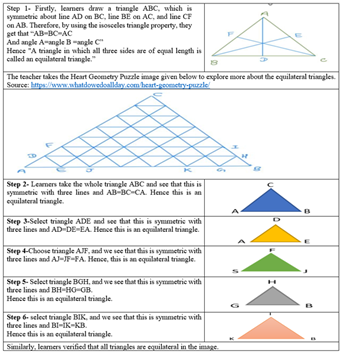
|
Table 9 Teacher Sketched Image-Based Equilateral Triangle Organization for
Students Source
https://www.whatdowedoallday.com/heart-geometry-puzzle/ |
Module No. 9 (“Right-angled triangle”)
To teach the “Right-angled triangle," authors have sketched the Image of Heart Poster. This image was created to calculate the area of the heart with the help of a small right-angled triangle.
Table 10
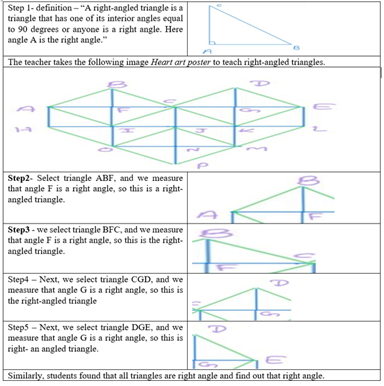
|
Table 10 Heart Poster Image-Based Right Angled Triangle Organization for Students |
Module No. 10 (“Acute angle Triangle”)
To teach “Acute angle triangle," authors have sketched the image of a rectangular poster prepared with triangles. This image was created for calculating the area of the rectangular box by dividing the box into an acute angle triangle.
Table 11
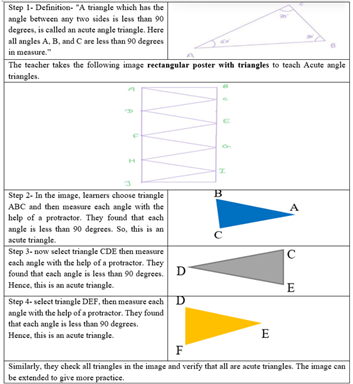
|
Table 11 Sketched Image-Based Acute Angle Triangle Organization for Students |
After conducting a ten-day Art-integrated Instructional intervention, a post-test (MAT) was administered.
3. Measures
The self-constructed mathematics achievement test, including the 25 items to measure learners’ math achievement, was used in this study. The MAT was constructed as per the Anderson Krathwohl taxonomy. The following items were constructed for each dimension of taxonomy, including Remembering (Six items), understanding (four items), Applying (Three items), Analyzing (Five items), Evaluating (three items), Creating (four items). The blueprint was developed before preparing the questionnaire following the weightage given to learning outcomes; contents (same topic as used in modules), and types of questions (True/False, Fill in the blank, Multiple-choice questions, Matching).
4. Data Analysis
The quantitative data analysis in this study involved several steps to obtain results. To achieve the second objective and answer the second research question, the scores obtained through the post-test (Mathematics Achievement Test) are shown in Table 1 given below.
Table 12
|
Table 12
Frequency Table of the Student’s Achievement |
|
|
Percentage Interval |
No of the Students (%) |
|
60-70 |
26 |
|
70-80 |
26 |
|
80-90 |
37 |
|
90-100 |
11 |
|
Total |
100 |
The results obtained and shown in the above table describe that the mathematical academic achievement scores are found in between 60 % to 100 %. The results are also better presented through Bar Graph given below.
Figure 1
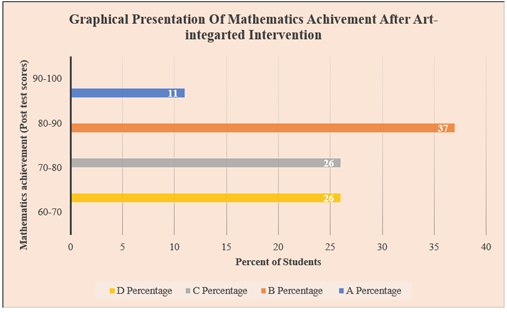
|
Figure 1 Percentage of Sample Student Vs. Student Mathematics Achievements |
(Here, A= 60%-70%, B=70%-80%, C=80%-90%, D=90%-100%)
The results shown in the graphical presentation described that 26% of students obtained marks between 60-70 percent marks, 26% of students obtained marks between 70-80, 37% of students obtained marks between 80-90, and 11 percent of students obtained scores between 90 -100 %.
The post-test was constructed based on a blueprint in which the weightage to learning outcomes (Anderson Krathwohl taxonomy) is also determined. Further, the post-test scores were analyzed to measure the achievement of learning outcomes those decided at the planning part of the art-integrated intervention.
Figure 1
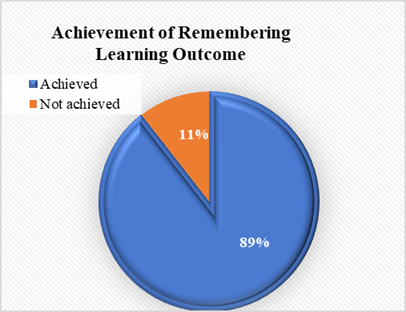
|
Figure 1 Distribution of Remembering Aspects |
Figure 2
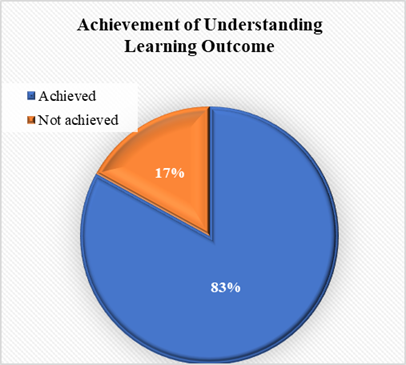
|
Figure 2 Distribution of Understanding Aspects |
Figure 3
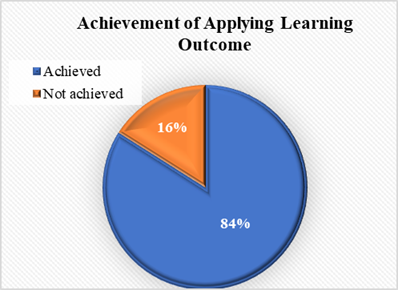
|
Figure 3 Distribution of Applying Aspects |
Figure 4
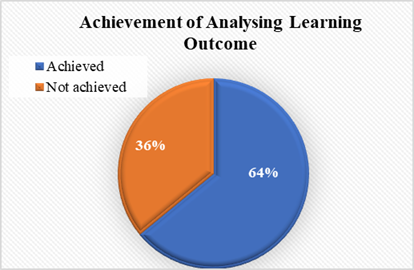
|
Figure 4 Distribution of Analysing Aspects |
Figure 5
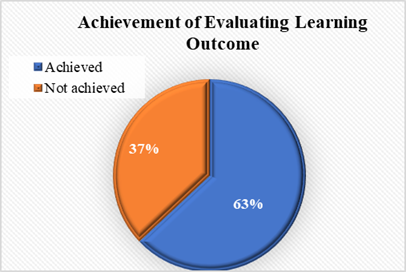
|
Figure 5 Distribution of Evaluating Aspects |
Figure 6
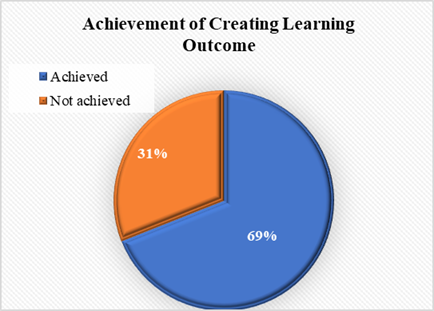
|
Figure 6 Distribution of Creating Aspects |
From the graphical presentation given in below in pie charts, it is concluded that achievement of remembering learning outcomes is 89 % (Fig.1), Understanding learning outcomes is 83 % (Fig. 2), and Applying learning outcomes is 84 % (Fig. 3), Analysing learning outcomes is 64% (Fig. 4), Evaluating learning outcomes is 63 % (Fig. 5) and Creating learning outcomes is 69 % (Fig. 6).
5. Findings
Regarding the Art integrated approach in mathematics of our conceptual model, we found that the presentation of the pictorial (folk art based) on the specific mathematical problem and their solution fostered the student’s interaction and engagement to discuss the mathematical ideas referred to as "Conceptual elaboration." However, the effect of the art-integration-based learning module on mathematics academic achievements of seventh-grade learners was found to be positive, and the extent involved in building learner's mathematical thinking. Furthermore, the Art-based conceptual elaboration regarding the novice nature of teaching moved through art-integrated instructional intervention and achievement of high-order cognitive abilities-based learning outcomes. Therefore, illustration-based interaction was quickly responded to by students. We found that art-based instructions were achieved at a higher level.
6. Discussion and Conclusion
As part of this study, “Art integration” was incorporated into the teaching of mathematics to provide students with a visual representation to relate mathematical concepts to various artistic images, including folk art and geometric images. Integrating the arts engages the learners and improves their comprehension skills. Art integration helps learners develop higher-order cognitive abilities. This research shows that analyzing, evaluating, and creating learning outcomes is achievable. This leads to the development of problem-solving skills, creative skills, and decision-making. Art integration teaching also connects learners to their culture, i.e., in this study, Warli folk art was used for art integration in the teaching module. In the same way, it can also include some other cultural arts. Our findings show the positive imperative impact of teaching the mathematical content of a topic. Several studies have revealed the remarkable results of integrating teaching with the arts.
The main aim of the research is to create a link between the two disciplines of Art and mathematics so that student learning becomes effective and engaging. Middle-aged learners need to engage in experiential learning within disciplines and the exploration of interdisciplinary relationships. Children feel happy and challenged, discover mathematics in folk design and architectural geometric Art, find mathematics useful in their lives, and have a positive understanding and attitude toward learning mathematics. Learners are more inclined to dabble in related fields later in learning.
The generalizability of the results is relatively constrained because our sample consisted of a small sample of 45 seventh-grade students who were proficient in foundational mathematical skills. In addition, we did not adopt the experimental design of the control group, did not present the comparison with traditional teaching methods, and did not conduct groupings in controlled situations. Instead, a diverse group of learners is our target group to understand the impact of integrating arts into math on students' math performance and higher-order cognitive academic performance, leading to better outcomes. Although there are some limitations, our research provides preliminary evidence that learners at the foundational level retain, understand, and better analyse and evaluate content when combined with the arts. At this level, especially learning outcomes are created, which are often overlooked in the teaching process. To provide a more useful scope for art integration, there is a need for large-scale art fusion research.
CONFLICT OF INTERESTS
None.
ACKNOWLEDGMENTS
None.
REFERENCES
National Education
Policy 2020. Ministry of Education, Government of India.
|
|
 This work is licensed under a: Creative Commons Attribution 4.0 International License
This work is licensed under a: Creative Commons Attribution 4.0 International License
© ShodhKosh 2024. All Rights Reserved.

